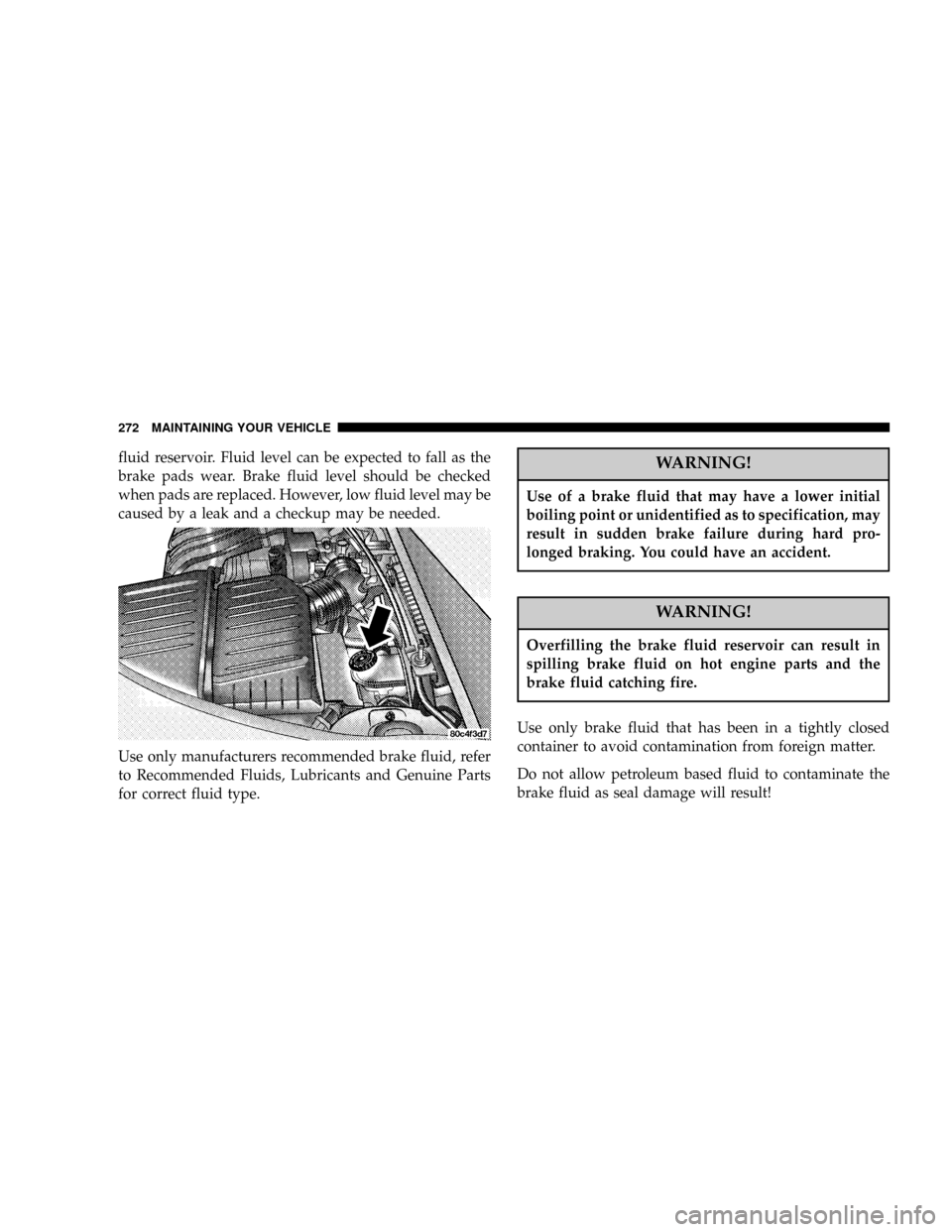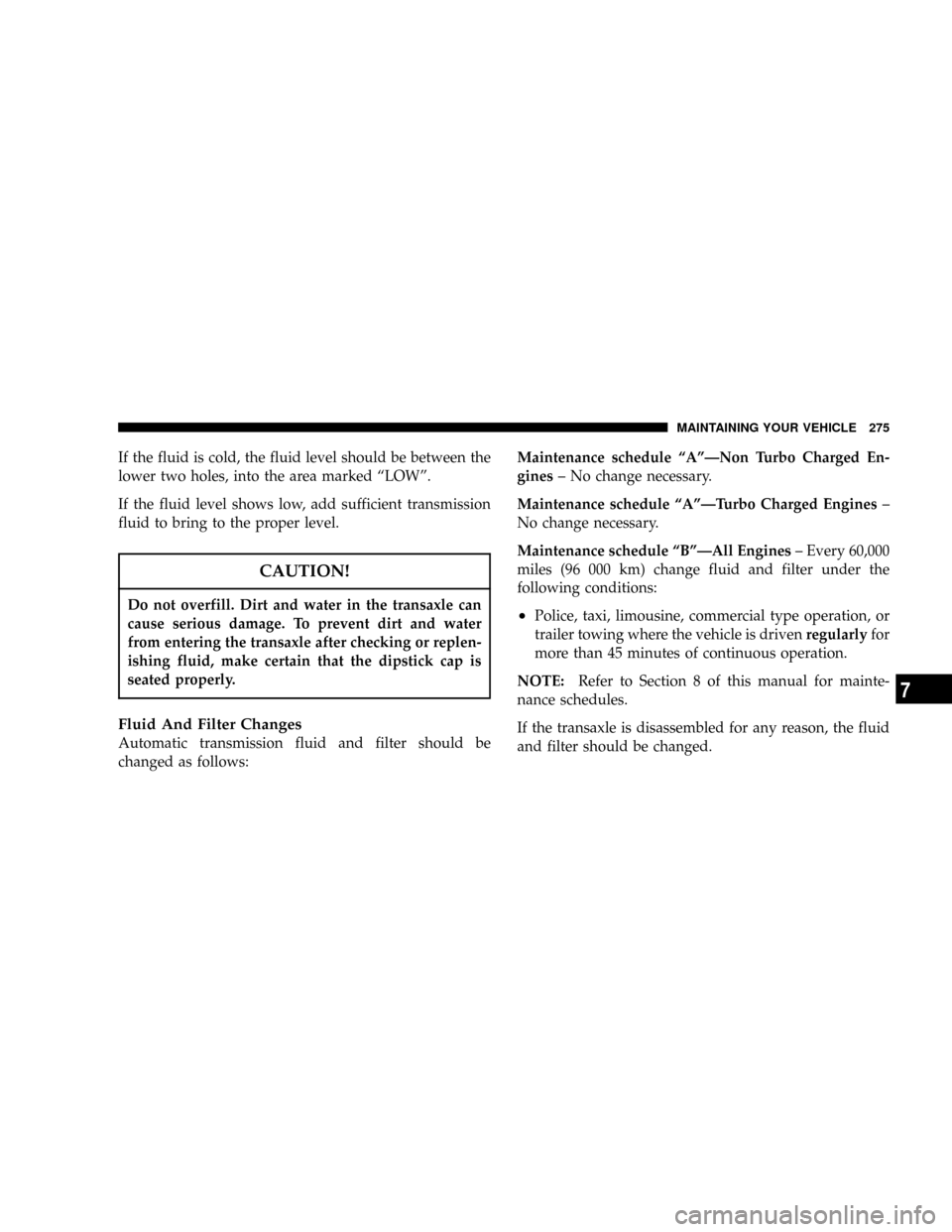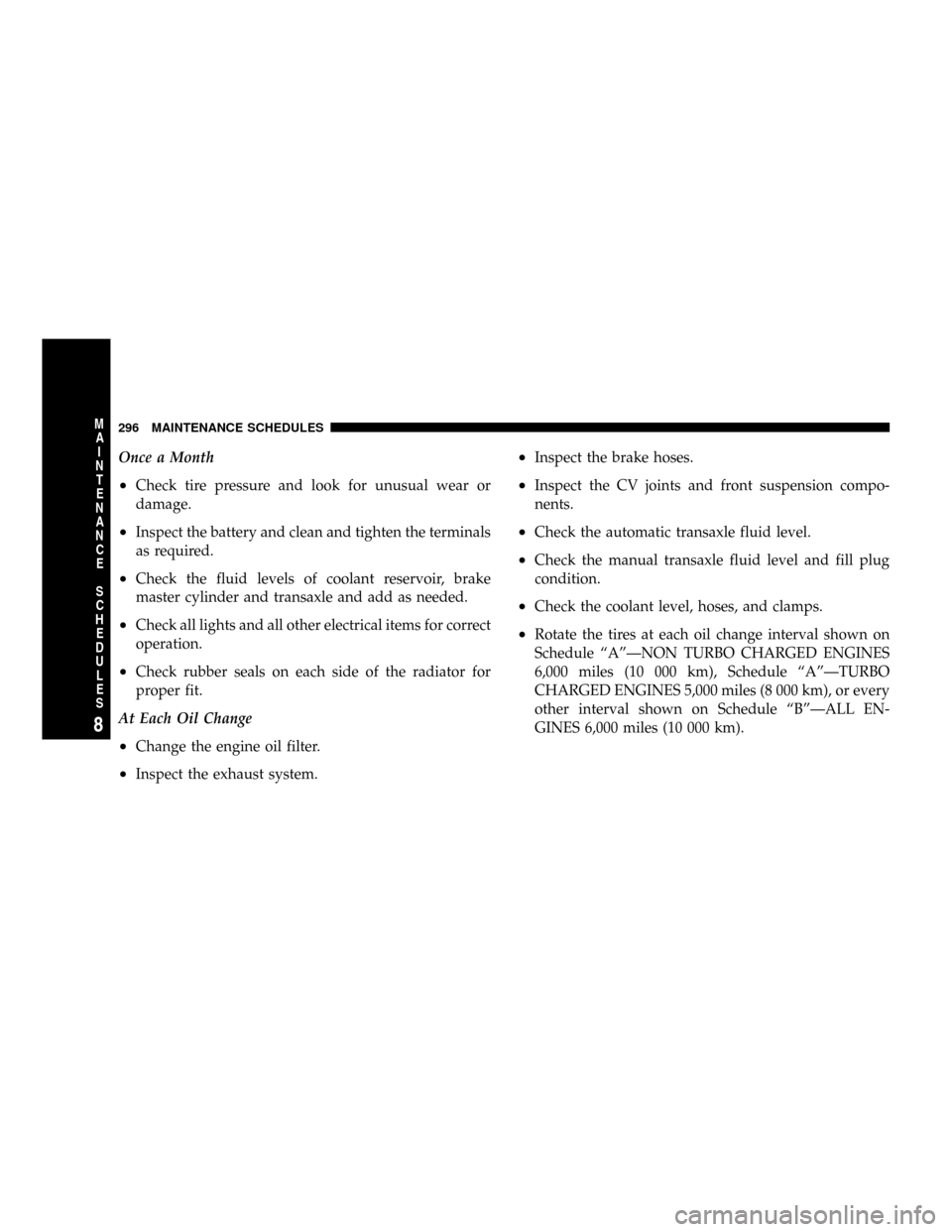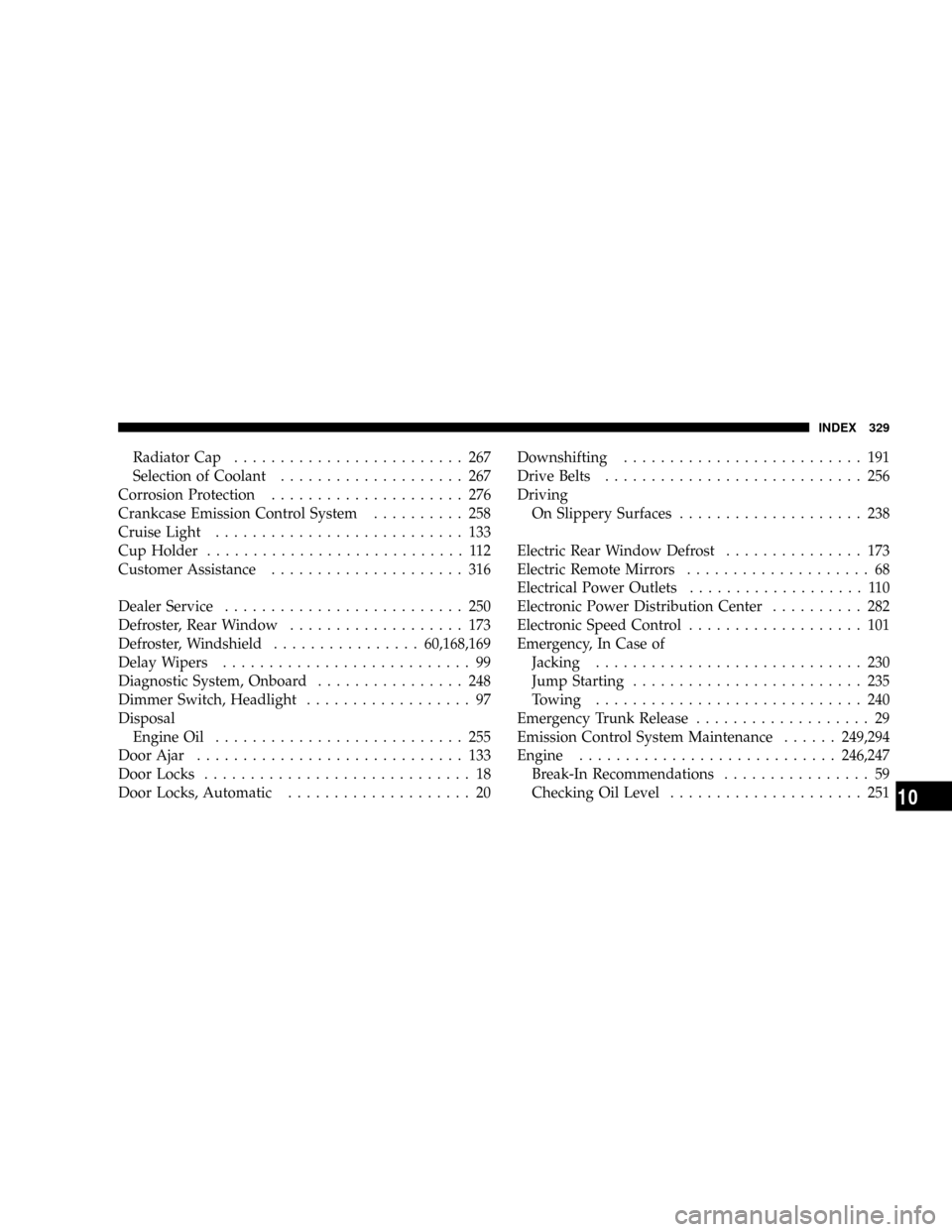check engine CHRYSLER PT CRUISER 2004 1.G Owner's Manual
[x] Cancel search | Manufacturer: CHRYSLER, Model Year: 2004, Model line: PT CRUISER, Model: CHRYSLER PT CRUISER 2004 1.GPages: 341, PDF Size: 5.06 MB
Page 269 of 341

humidity accumulation on the radiator and being vapor-
ized when the thermostat opens, allowing hot water to
enter the radiator.
If an examination of your engine compartment shows no
evidence of radiator or hose leaks, the vehicle may be
safely driven. The vapor will soon dissipate.
²Do not overfill the coolant recovery bottle.
²Check coolant freeze point in the system.
²If frequent coolant additions are required, the cooling
system should be pressure tested for leaks.
²Maintain coolant concentration at 50% ethylene glycol
antifreeze (minimum) in water for proper corrosion
protection of your engine which contains aluminum
components.
²Make sure that the radiator and coolant recovery
bottle hoses are not kinked or obstructed.
²Keep the front of the radiator clean. If your vehicle has
air conditioning, keep the front of the condenser clean,
also.
²Do not change the thermostat for summer or winter
operation. If replacement is ever necessary, install
ONLY the correct type thermostat. Other designs may
result in unsatisfactory coolant performance, poor gas
mileage, and increased emissions.
Hoses And Vacuum/Vapor Harnesses
Inspect surfaces of hoses and nylon tubing for evidence
of heat and mechanical damage. Hard or soft spots,
brittle rubber, cracking, tears, cuts, abrasions, and exces-
sive swelling indicate deterioration of the rubber
Pay particular attention to the hoses nearest to high heat
sources such as the exhaust manifold. Inspect hose rout-
ing to be sure hoses do not touch any heat source or
moving component that may cause heat damage or
mechanical wear.
MAINTAINING YOUR VEHICLE 269
7
Page 271 of 341

brittle rubber, cracking, tears, cuts, abrasions, and exces-
sive swelling suggest deterioration of the rubber. Particu-
lar attention should be made to examining those hose
surfaces nearest to high heat sources, such as the exhaust
manifold.
Inspect all hose clamps and couplings to make sure they
are secure and no leaks are present.
Insure nylon tubing in these areas has not melted or
collapsed.
NOTE:Often, fluids such as oil, power steering fluid,
and brake fluid are used during assembly plant opera-
tions to ease the assembly of hoses to couplings. There-
fore, oil wetness at the hose-coupling area is not neces-
sarily an indication of leakage. Actual dripping of hot
fluid when systems are under pressure (during vehicle
operation) should be noted before a hose is replaced
based on leakage.NOTE:Inspection of brake hoses should be done when-
ever the brake system is serviced and at every engine oil
change.
WARNING!
Worn brake hoses can burst and cause brake failure.
You could have an accident. If you see any signs of
cracking, scuffing, or worn spots, have the brake
hoses replaced immediately.
Brake Master Cylinder
The fluid level in the master cylinder should be checked
when performing under hood services, or immediately if
the brake system warning lamp is on.
Be sure to clean the top of the master cylinder area before
removing the cap. If necessary, add fluid to bring the
fluid level up to the requirements described on the brake
MAINTAINING YOUR VEHICLE 271
7
Page 272 of 341

fluid reservoir. Fluid level can be expected to fall as the
brake pads wear. Brake fluid level should be checked
when pads are replaced. However, low fluid level may be
caused by a leak and a checkup may be needed.
Use only manufacturers recommended brake fluid, refer
to Recommended Fluids, Lubricants and Genuine Parts
for correct fluid type.WARNING!
Use of a brake fluid that may have a lower initial
boiling point or unidentified as to specification, may
result in sudden brake failure during hard pro-
longed braking. You could have an accident.
WARNING!
Overfilling the brake fluid reservoir can result in
spilling brake fluid on hot engine parts and the
brake fluid catching fire.
Use only brake fluid that has been in a tightly closed
container to avoid contamination from foreign matter.
Do not allow petroleum based fluid to contaminate the
brake fluid as seal damage will result!
272 MAINTAINING YOUR VEHICLE
Page 274 of 341

Procedure For Checking Fluid Level
To properly check the automatic transaxle fluid level, the
following procedure must be used:
1. The vehicle must be on level ground.
2. The engine should be running at curb idle speed for a
minimum of 60 seconds.
3. Fully apply parking brake.
4. Place the gear selector momentarily in each gear
position ending with the lever in P (PARK).
5. Remove the dipstick and determine if the fluid is hot
or warm. Hot fluid is approximately 180ÉF (82ÉC) which
is the normal operating temperature after the vehicle has
been driven at least 24 km (15 miles). The fluid cannot be
comfortable held between the finger tips. Warm is when
the fluid is between 85É to 125ÉF (29É to 52ÉC).6. Wipe the dipstick clean and reinsert until seated.
Remove dipstick and note reading.
If the fluid is hot, reading should be in the cross hatched
area marked ªHOTº between the upper two holes in the
dipstick.
274 MAINTAINING YOUR VEHICLE
Page 275 of 341

If the fluid is cold, the fluid level should be between the
lower two holes, into the area marked ªLOWº.
If the fluid level shows low, add sufficient transmission
fluid to bring to the proper level.
CAUTION!
Do not overfill. Dirt and water in the transaxle can
cause serious damage. To prevent dirt and water
from entering the transaxle after checking or replen-
ishing fluid, make certain that the dipstick cap is
seated properly.
Fluid And Filter Changes
Automatic transmission fluid and filter should be
changed as follows:Maintenance schedule ªAºÐNon Turbo Charged En-
gines± No change necessary.
Maintenance schedule ªAºÐTurbo Charged Engines±
No change necessary.
Maintenance schedule ªBºÐAll Engines± Every 60,000
miles (96 000 km) change fluid and filter under the
following conditions:
²Police, taxi, limousine, commercial type operation, or
trailer towing where the vehicle is drivenregularlyfor
more than 45 minutes of continuous operation.
NOTE:Refer to Section 8 of this manual for mainte-
nance schedules.
If the transaxle is disassembled for any reason, the fluid
and filter should be changed.
MAINTAINING YOUR VEHICLE 275
7
Page 295 of 341

²Off-road or desert operation.
²If equipped for and operating with E-85 (ethanol)
fuel.
NOTE:IfANYof these apply to you then change your
engine oil every 3,000 miles (5 000 km) or 3 months,
whichever comes first and follow schedule ªBÐAll En-
ginesº of the9Maintenance Schedules9section of this
manual.
NOTE:Most vehicles are operated under the conditions
listed for Schedule9B9ÐALL ENGINES.
Second is ScheduleªAºÐNON TURBO CHARGED
ENGINES. It is for vehicles that are not operated under
any of the conditions listed under Schedule9B9ÐALL
ENGINES.
Third is ScheduleªAºÐTURBO CHARGED ENGINES.
It is for vehicles that are not operated under any of the
conditions listed under Schedule9B9ÐALL ENGINES.Use the schedule that best describes your driving condi-
tions. Where time and mileage are listed, follow the
interval that occurs first.
CAUTION!
Failure to perform the required maintenance items
may result in damage to the vehicle.
At Each Stop for Fuel
²Check the engine oil level about 5 minutes after a fully
warmed engine is shut off. Checking the oil level while
the vehicle is on level ground will improve the accu-
racy of the oil level reading. Add oil only when the
level is at or below the ADD or MIN mark.
²Check the windshield washer solvent and add if
required.
MAINTENANCE SCHEDULES 295
8
M
A
I
N
T
E
N
A
N
C
E
S
C
H
E
D
U
L
E
S
Page 296 of 341

Once a Month
²Check tire pressure and look for unusual wear or
damage.
²Inspect the battery and clean and tighten the terminals
as required.
²Check the fluid levels of coolant reservoir, brake
master cylinder and transaxle and add as needed.
²Check all lights and all other electrical items for correct
operation.
²Check rubber seals on each side of the radiator for
proper fit.
At Each Oil Change
²Change the engine oil filter.
²Inspect the exhaust system.
²Inspect the brake hoses.
²Inspect the CV joints and front suspension compo-
nents.
²Check the automatic transaxle fluid level.
²Check the manual transaxle fluid level and fill plug
condition.
²Check the coolant level, hoses, and clamps.
²Rotate the tires at each oil change interval shown on
Schedule ªAºÐNON TURBO CHARGED ENGINES
6,000 miles (10 000 km), Schedule ªAºÐTURBO
CHARGED ENGINES 5,000 miles (8 000 km), or every
other interval shown on Schedule ªBºÐALL EN-
GINES 6,000 miles (10 000 km).
296 MAINTENANCE SCHEDULES
8
M
A
I
N
T
E
N
A
N
C
E
S
C
H
E
D
U
L
E
S
Page 326 of 341

ABS (Anti-Lock Brake) System.............. 194
Adding Engine Coolant (Antifreeze).......... 267
Adding Fuel........................... 221
Adding Washer Fluid..................... 175
Additives, Fuel......................... 219
Air Cleaner, Engine...................... 258
Air Conditioning........................ 261
Air Conditioning Controls................. 166
Air Conditioning, Operating Tips............ 171
Air Conditioning Refrigerant............... 261
Air Conditioning System................166,261
Air Pressure, Tires....................... 207
Airbag................................ 41
Airbag Deployment....................... 48
Airbag Light.....................45,50,60,134
Airbag Maintenance....................... 49
Airbag, Side............................ 47
Alarm, Panic............................ 23
Alarm System........................26,129Alignment and Balance................... 213
Alterations/Modifications, Vehicle............. 7
Antenna, Satellite Radio................... 164
Antifreeze (Engine Coolant)...........267,290,291
Capacities........................... 290
Anti-Lock Brake System................... 194
Anti-Lock Warning Light.................. 131
Anti-Theft Security Alarm.................. 26
Appearance Care........................ 276
Auto Down Power Windows................ 31
Automatic Door Locks..................... 20
Automatic Transaxle..............12,180,183,273
Fluid and Filter Changes................. 275
Fluid Level Check...................273,274
Interlock System.....................18,184
Reset Mode.......................... 184
Selection Of Lubricant................... 273
Shifting............................. 185
Special Additives...................... 276
326 INDEX
Page 329 of 341

Radiator Cap......................... 267
Selection of Coolant.................... 267
Corrosion Protection..................... 276
Crankcase Emission Control System.......... 258
Cruise Light........................... 133
Cup Holder............................ 112
Customer Assistance..................... 316
Dealer Service.......................... 250
Defroster, Rear Window................... 173
Defroster, Windshield................60,168,169
Delay Wipers........................... 99
Diagnostic System, Onboard................ 248
Dimmer Switch, Headlight.................. 97
Disposal
Engine Oil........................... 255
Door Ajar............................. 133
Door Locks............................. 18
Door Locks, Automatic.................... 20Downshifting.......................... 191
Drive Belts............................ 256
Driving
On Slippery Surfaces.................... 238
Electric Rear Window Defrost............... 173
Electric Remote Mirrors.................... 68
Electrical Power Outlets................... 110
Electronic Power Distribution Center.......... 282
Electronic Speed Control................... 101
Emergency, In Case of
Jacking............................. 230
Jump Starting......................... 235
Towing............................. 240
Emergency Trunk Release................... 29
Emission Control System Maintenance......249,294
Engine............................246,247
Break-In Recommendations................ 59
Checking Oil Level..................... 251
INDEX 329
10
Page 330 of 341

Exhaust Gas Caution.................... 220
Fuel Requirements..................... 216
Jump Starting......................... 235
Oil ...........................251,290,291
Oil Change Interval.................... 252
Oil Filter............................ 291
Oil Selection.......................... 253
Oil Synthetic......................... 255
Overheating.......................... 228
Temperature Gauge..................... 130
Timing Belt.......................... 258
Engine Oil Viscosity Chart................. 254
Exhaust Gas Caution..............28,59,220,264
Exhaust System......................... 264
Filler Location Fuel...................... 135
Filters
Air Cleaner.......................... 258
Engine Fuel.......................... 258Engine Oil........................255,291
Flashers.............................. 228
Hazard Warning....................... 228
Flat Tire Stowage........................ 235
Flooded Engine Starting................... 181
Fluid, Brake........................... 292
Fluid Capacities......................... 290
Fluid Leaks............................. 61
Fluid Level Checks
Automatic Transaxle.................... 273
Fog Light Service........................ 288
Fog Lights...........................97,135
Folding Rear Seat........................ 86
Freeing A Stuck Vehicle................... 239
Fuel..............................216,291
Adding............................. 221
Additives............................ 219
Capacity............................ 290
Clean Air............................ 217
330 INDEX